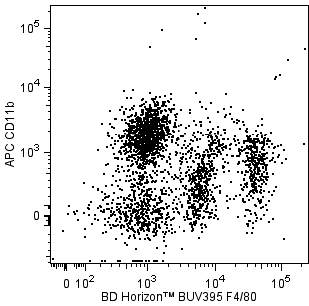Old Browser
Looks like you're visiting us from {countryName}.
Would you like to stay on the current country site or be switched to your country?


.png)

Two-color flow cytometric analysis of CRIg expression on mouse peritoneal macrophages. Resident peritoneal cells were harvested from BALB/c mice, washed, and then stained with BD Horizon™ BUV395 Rat Anti-Mouse F4/80 antibody (Cat. No. 565614) and either PE Rat IgG2a, κ Isotype Control (Cat. No. 553930; Middle Plot) or PE Rat Anti-Mouse CRIg antibody (Cat. No. 566737; Right Plot) at 0.5 µg/test. Two-color flow cytometric dot plots showing the correlated expression of CRIg (or Ig Isotype control staining) versus F4/80 were derived from gated events with the forward and side light-scatter characteristics of viable macrophages (Left Plot). Flow cytometry and data analysis were performed using a BD LSRFortessa™ Cell Analyzer System and FlowJo™ software. Data shown on this Technical Data Sheet are not lot specific.
.png)

BD Pharmingen™ PE Rat Anti-Mouse CRIg
.png)
监管状态图例
未经BD明确书面授权,严禁使用未经许可的任何商品。
准备和存储
商品通知
- Since applications vary, each investigator should titrate the reagent to obtain optimal results.
- An isotype control should be used at the same concentration as the antibody of interest.
- Caution: Sodium azide yields highly toxic hydrazoic acid under acidic conditions. Dilute azide compounds in running water before discarding to avoid accumulation of potentially explosive deposits in plumbing.
- For fluorochrome spectra and suitable instrument settings, please refer to our Multicolor Flow Cytometry web page at www.bdbiosciences.com/colors.
- Please refer to www.bdbiosciences.com/us/s/resources for technical protocols.
配套商品


.png?imwidth=320)

The 17C9 monoclonal antibody specifically recognizes Complement receptor of the immunoglobulin superfamily (CRIg) which is encoded by the Vsig4 (V-set and immunoglobulin domain containing 4) gene. CRIg is a ~45 kDa single-pass type I transmembrane glycoprotein that contains a variable (V-type) immunoglobulin domain in its extracellular region which is required for binding complement components and promoting phagocytosis. CRIg is expressed on Kupffer cells and tissue resident macrophages, including a subset of resident peritoneal macrophages. CRIg binds complement fragments C3b and iC3b and plays important roles in innate and adaptive immunity. This complement receptor is involved in regulation of the complement cascade and serves as a phagocytic receptor in the clearance of pathogens, immune complexes, and apoptotic cells. CRIg-positive macrophages can reportedly function in the negative regulation of T-cell proliferation and IL-2 production.

研发参考 (4)
-
Fu W, Wojtkiewicz G, Weissleder R, Benoist C, Mathis D. Early window of diabetes determinism in NOD mice, dependent on the complement receptor CRIg, identified by noninvasive imaging. Nat Immunol. 2012; 13(4):361-368. (Clone-specific: Flow cytometry). 查看参考
-
Helmy KY, Katschke KJ, Jr., et al. CRIg: a macrophage complement receptor required for phagocytosis of circulating pathogens. Cell. 2006; 124(5):915-927. (Biology). 查看参考
-
Small AG, Al-Baghdadi M, Quach A, Hii C, Ferrante A. Complement receptor immunoglobulin: a control point in infection and immunity, inflammation and cancer. Swiss Med Wkly. 2016; 146:w14301. (Biology). 查看参考
-
Vogt L, Schmitz N, Kurrer MO, et al. VSIG4, a B7 family-related protein, is a negative regulator of T cell activation. J Clin Invest. 2006; 116(10):2817-2826. (Biology). 查看参考
Please refer to Support Documents for Quality Certificates
Global - Refer to manufacturer's instructions for use and related User Manuals and Technical data sheets before using this products as described
Comparisons, where applicable, are made against older BD Technology, manual methods or are general performance claims. Comparisons are not made against non-BD technologies, unless otherwise noted.
For Research Use Only. Not for use in diagnostic or therapeutic procedures.
Report a Site Issue
This form is intended to help us improve our website experience. For other support, please visit our Contact Us page.